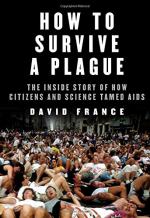|
This section contains 553 words (approx. 2 pages at 400 words per page) |

|
How to Survive a Plague: The Inside Story of How Citizens and Science Tamed AIDS Summary & Study Guide Description
How to Survive a Plague: The Inside Story of How Citizens and Science Tamed AIDS Summary & Study Guide includes comprehensive information and analysis to help you understand the book. This study guide contains the following sections:
This detailed literature summary also contains Topics for Discussion on How to Survive a Plague: The Inside Story of How Citizens and Science Tamed AIDS by David France.
The following version of this book was used to create this study guide: France, David. How to Survive a Plague: The Inside Story of How Citizens and Scientists Tamed AIDS. Alfred A. Knopf, 2016.
How to Survive a Plague: The Inside Story of How Citizens and Scientists Tamed AIDS by David France describes the AIDS epidemic of the 1980s and early 1990s. The disease first appeared among gay men, and was primarily concentrated in the gay community, though every segment of the population was impacted. The epidemic was also a global one, affecting people in both developed and developing countries. This book focuses on events in New York City and the United States more broadly. France provides a comprehensive factual account of these events while also including his own perspective as a gay man who lived through the plague.
The narrative opens in the late 1970s, just after the author moves to New York City. Sporadic news reports noted a mysterious disease seemingly concentrated among the gay community, but it received very little attention among the general public. A small number of doctors who specialized in treating gay men noticed that their patients were stricken with a high number of infectious diseases, including ones that typically affected only those with compromised immune systems. Though extremely under-resourced, these doctors, most notably Dr. Joe Sonnabend, began researching possible causes for the disease. Simultaneously, members of the gay community began organizing to provide support to patients and advocate for better treatments. Their early efforts focused on connecting patients to social services and encouraging others to adopt safe sex practices, which showed promise in preventing the spread of the disease. Meanwhile, the gay community faced rampant discrimination with hospitals refusing to treat AIDS patients. As publicity of the epidemic increased, public backlash increased with some people calling for quarantines of people with AIDS or the entire gay community. Religious leaders implied that gay men deserved to be afflicted by the disease because of their immoral lifestyle.
Researchers eventually determined that the disease, referred to as AIDS was caused by a retrovirus, later named HIV. It attacked the body’s immune system, opening it up to possibly fatal infections. In the absence of effective treatments, thousands of people with AIDS died every year. Those who lived dealt with debilitating and painful symptoms. A single antibiotic, AZT, was developed by drugmakers with the support of federal officials. However, it caused significant side effects and was only tolerable to 50% of patients. Activists, therefore, became focused on encouraging the government and drugmakers to develop new treatments and make them as widely available as possible. One of the primary groups involved in this activism was ACT UP, which led organized years of protests against federal agencies like the FDA and NIH. These agencies, they argued, were unreceptive to the needs of AIDS patients and far too slow to react. Only after over a decade of pressure, were effective treatments developed, allowing people to live generally normal lives despite being infected with HIV.
In addition to the broad historical narrative, France injects frequent personal anecdotes about his friends and acquaintances who suffered or died from the disease. In doing so, he adds a personal element to story, allowing the reader to better understand the emotional toll the disease had on those affected.
Read more from the Study Guide
|
This section contains 553 words (approx. 2 pages at 400 words per page) |

|



